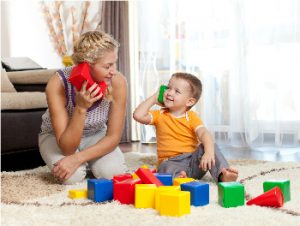
A Childs Need for Play – by Stephen Fite
At this time of year, children’s toys and games are a hot topic of conversation and a source of parental consternation as we brave the crowds to successfully check off each item from “their” list. Sometimes the drama of the quest can be quite epic, but the rewards from that playtime will be quite evident as our children grow. Much has been discussed over the years about the role of Play in a child’s education. Those who have been involved in Early Childhood know that Play is an essential component in the development of children emotionally, socially, cognitively and physically. The following are responses to questions I answered a few years back for a parent magazine in preparation for an article about this very subject.
- How important is play to children?
“A Child’s Play is Learning” is a catchphrase often heard in early childhood circles. For more than four decades, educators and child advocates have held firm to this belief and backed it up with the formation of the International Association for the Child’s Right to Play in 1961. Through the experience of games and activities, children develop a sense of self and self-worth, all the while contributing to their social, emotional, intellectual and physical growth.
- What are some tips for using play to teach basic everyday skills?

Ask questions of your child during that interactive playtime. Ex: If you’re building with blocks you could ask, “What shape is that block you are holding?” “What color is it?” “If you put these two arch pieces together, what shape will it make?” “How many blocks are in this stack?” “Can you sort all the blocks according to size, shape, color, etc.?” You can transfer that methodology to most any activity. Aside from the building of basic skills, you are building language and vocabulary, which will be the basis from which your child will learn to read.
- How do children learn through play?
Socially through interaction with others they learn how to lead, how to follow, how to initiate, how to mediate, how to be inclusive and fair to others. Emotionally as they encounter circumstances and situations that will both challenge and develop their sense of self-control and sportsmanship. Intellectually as they learn about rules, time, strategy, parameters, space, cause and effect and the world around them. Physically as they develop coordination, strength, large and small motor skills, eye/hand coordination, speed, agility and more. In a nutshell, children learn best when they are in motion, active, exploring and manipulating their environment.
- How important is it in providing the proper “tools” for constructive play.

While having a good supply of games and outdoor activities available is a must, there are times that the need for imaginative creation can be much more educational for children. The self-esteem and fulfillment derived from the spontaneous, or even time intensive development of a new game or plaything is priceless. Be it a makeshift pots and pans band, homemade rhythm instruments, self-made mazes, a unique twist on an old game, or even setting up a stage in the living room and giving a concert, this type of “make your own fun” play is invaluable to a child’s development.
- What are some unusual ways we can help our kids learn through the avenue of play?
By creating a song to sing together while you are interacting with your child. Piggyback songs are easy to create and promote a special bond you and your child will remember long after they have left the roost. You can create lyrics for most any game you are playing. Ex: “The square block goes here, the square block goes here. Hi, Ho did you know the square block goes here.” (The Farmer In The Dell) You can also develop clean-up songs, bedtime and bath time songs, etc.
During the Impressionistic era of music, composers such as Debussy endeavored to create “musical murals” that would audibly transport the listener into a scene or setting. His composition, Afternoon of a Fawn is an example of this style of writing. Try using music as the object or subject during any art experiences. Select a piece of music and encourage your child to draw or paint what they see in the music. It can be as simple as using Itsy-Bitsy Spider or Old MacDonald or any other music for children.
Create a “Cake Walk” game in your own house by writing numbers, letters, colors, or even sight words on different pieces of paper. Put them in a circle and have your child walk around, stepping on each one until the music ends. Have them identify the number, letter on which they are standing.
